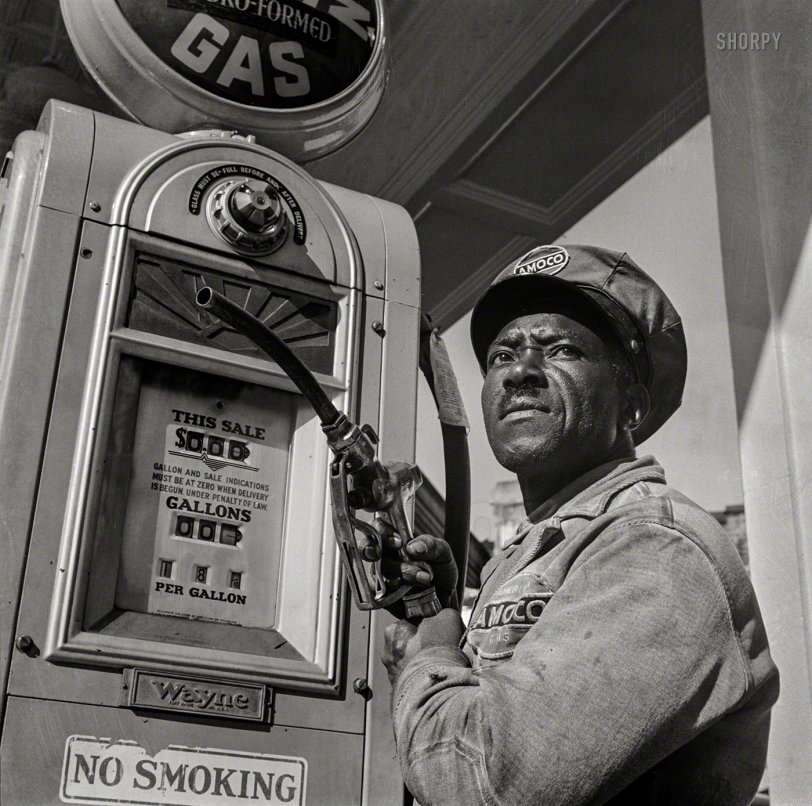


Framed or unframed, desk size to sofa size, printed by us in Arizona and Alabama since 2007. Explore now.
Shorpy is funded by you. Patreon contributors get an ad-free experience.
Learn more.

- Freeze Frame
- Texas Flyer wanted
- Just a Year Too Soon
- WWII -- Replacing men with women at the railroad crossing.
- Yes, Icing
- You kids drive me nuts!
- NOT An Easy Job
- I wonder
- Just add window boxes
- Icing Platform?
- Indiana Harbor Belt abides
- Freezing haze
- Corrections (for those who care)
- C&NW at Nelson
- Fallen Flags
- A dangerous job made worse
- Water Stop
- Passenger trains have right of way over freights?
- Coal
- Never ceases to amaze me.
- Still chuggin' (in model form)
- Great shot
- Westerly Breeze
- For the men, a trapeze
- Tickled
- Sense of loneliness ...
- 2 cents
- Charm City
- What an Outrage
- Brighton Park
Print Emporium
American Gas: 1942

November 1942. Washington, D.C. "Negro mechanic for the Amoco oil company." Photo by Gordon Parks for the Office of War Information. View full size.
Gas Station Dings
I had forgotten how musical gas stations used to be. Another device that "dinged" was the old style air pumps. You turned a crank to set the air pressure for your tires, and as the air filled the tire it occasionally dinged, and then automatically stopped at the desired PSI. The air hose was looped over a bracket, and when you removed the hose the bracket lifted up and the air pump started. A sign reminded you to replace the hose on the bracket to turn off the pump.
Well, tterrace, the gas pumps really did "ding" for each gallon of gas pumped. Here is a video that shows everything you need to know about restoring old gas pumps.

Re: Ding-Ding
I too remember the air-hose bell, but do I also remember a ding-ding sound as the gas pumped, or is my memory making stuff up (as it is increasingly wont to do)?
[I can remember hearing that, but I don't know if it was in real life or just in old movies. -tterrace]
'Ding-Ding'
Of the air hose bell when you pulled in for your dollars worth of regular. Still can hear that sound.
Gas Pump
... was a "Wayne." Manufactured in Ft. Wayne, Indiana. Subsequently bought out and now know as the Wayne Fueling Systems division of Dover Fueling Solutions. But not in Indiana.
7/10?
I have never seen 7/10 instead of 9/10! I wondered if (at that low price) there was actually price competition at the fraction of a cent?
Reset to Zero
I remember those "spinny things" as well, and through the clear glass you could see the different colours for specific fuels. I seem to recall in the 1950s that regular gas was a light amber, whereas high octane was pink. After each fuelling, the attendant turned a crank on the side of the pump, and this reset the price and number of gallons to zero.
In the 1970s when I first owned a car, you might be presented with a memento as well, such as a glass or a savings coupon. And if you bought gas at an Esso station, there was a tiger tail attached to your fuel cap. This was part of the "Put a Tiger in Your Tank" advertising promotion. This all came to an end with self-serve gas station.
We've come far, but we've also lost much.
I miss the spinny things on gas pumps!
The product of the times.
Gasoline is 18.7 cents a gallon, which I actually remember. I am appalled by the reduction of the pump attendant being reduced to a "Negro", as if his skin color had anything to do with his abilities. Like a white person could do a more remarkable job of pumping gasoline? In the dominant culture of the time, it was accepted practice, but in 2017, it makes me shudder.
[Illustrating ethnic, religious and racial diversity in American society was one of the primary aims of the OWI photo project, so such specifics were always recorded with the exposures. -tterrace]
[The photographer (who wrote the caption) was none other than Gordon Parks. - Dave]
About the same price today.
Adjusting for inflation, and rounding that 18.7 up to 19 cents, it comes out to $2.80 per gallon.
Of course back then you got the oil checked, window washed, tires aired up, and so on.
























On Shorpy:
Today’s Top 5